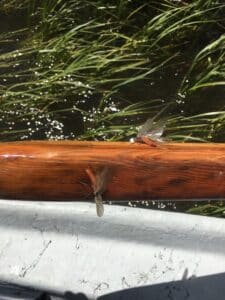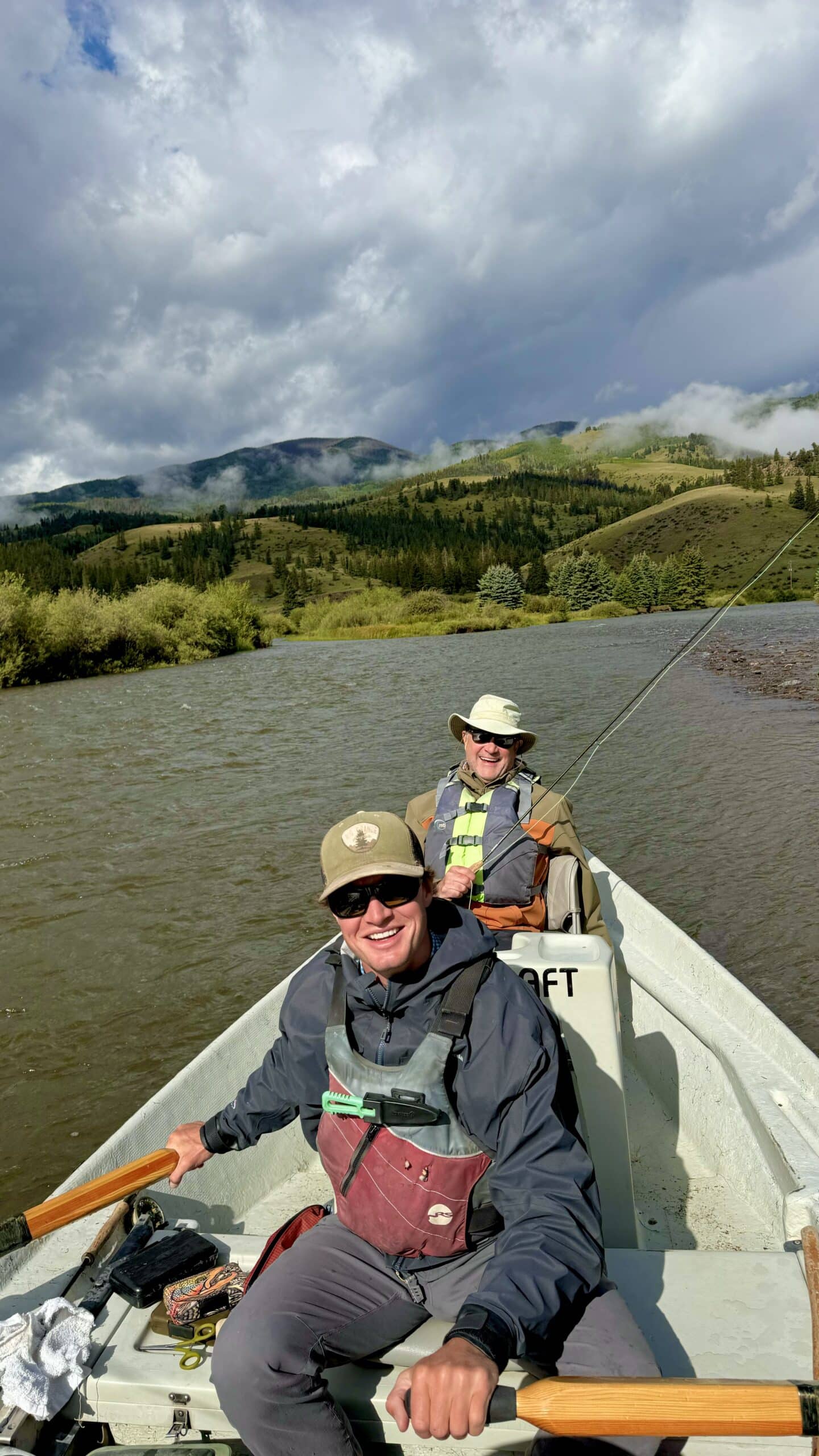“What about the perfect drift? I’ve been practicing this mend for 20 years! You’re telling me to twitch my flies and put movement on them?”
That’s right! Bring some life to the party with the twitch. This blog will talk about the best times to twitch your flies and some of the techniques we use to do it. It will also cover the best times NOT to twitch your flies.
When to twitch my fly based on insect
I always like to think about what type of bugs I’m imitating and what life cycle they are in when fishing. Whether I am fishing hoppers in late summer or baetis patterns in the spring, there is always a time and place for a twitch.
Salmon flies

Salmon flies in the trees
One of my favorite patterns to add a lot of movement to are salmon fly patterns. It adds to the dry fly fishing experience and elicits some very explosive eats. When I think of dirty or stained water I picture a big, fast flowing, up in the trees and bushes river. Post runoff when everything is starting to clear up and salmon flies are pushing up on the bank.
When I start to see salmon flies bouncing on the water, skittering on the surface, and falling out of trees when clients hook a branch and drop 100 grams of bug protein on the water, I know it’s time to put some movement on the flies.
Many of the new school salmon fly patterns are foam and have a pronounced lip on the fly. This is perfect for popping or dancing a fly pattern. They are very buoyant and will stay afloat much more than the classic sofa pillow.
When adding a twitch or “pop” to this type of pattern, there are plenty of techniques out there. My favorite way to move this type of fly and ensure the most hookups, is to keep my rod tip low and pointed at the fly, elevate the tip of your rod a foot or so and throw and mend directly at your fly. As you do this, strip in half an arms length worth of line. You will see this pops/ skitters your fly across the surface while keeping nice tension with your fly.
With so many bugs on the water during this time of hatch, putting some life in your fly can really make the difference. Oftentimes, the salmon flies bouncing around and skittering on the surface have more protein than others due to the large egg sack the females are carrying around. I have seen over and over how a fish will pass up natural flies to eat a twitched and popped salmon fly imitation.

Salmon fly fishing
Times NOT to twitch during a salmon fly fishing is when the hatch is dying off. There are not many bugs still hatching and most of them have laid their eggs and are done mating. You will see trees and bushes filled with bugs that are dead or very close to. If you shake a bush and they all fall on the water without much movement at all. Typically the water will be much clearer by this point and the hatch will have been going on for 2-4 weeks.
During this time period I really do like the traditional one mend and let er’ ride technique. If all the bugs on the water are still and not moving, either keep your bug still or do very small movements on it. Although the erratic action may still work, I have found I catch nicer fish when being still during this phase of salmon fly life.
Caddis
(Dry Fly Caddis)
Talk about a real blow up and visual eat! Skittering caddis can be one of the most fun dry fly fishing experiences available. With this often being the first hatch of the big bugs in our area, skittering caddis feels like the start of summer. Very similar to twitching a salmon fly during the phase of a hatch, I use a slightly different technique with caddis.
After making a cast into the cloud of caddis moving up the bank, I put my first initial mend on the water. I will then slowly lift my rod tip while doing side to side twitches (2-6 inches) until i’m ready for another cast. One thing I like to pay attention to here is when the fish is eating my fly. If they are eating it mid skate then my goodness we are on some HOT fish. I love when this is the case. A lot of the time, you will finish your rod twitch and the second your fly dead drifts it will be exploded on. If you can expect this to happen then your hookup ratio will go up.
Key in on where the fish are holding in the stream. If they are tight to the bank (assuming you’re fishing out of the boat) then make a nice tight cast to the bank, SMALL skate and twitch and POW! If you know the fish are holding 4-6 off the bank (or further) then you can make your skates longer and more pronounced. The key is to skate the fly into the fish, not away from them.
(Emerging Caddis)

Caddis Hatch
At the very start of a caddis hatch there can be excellent sub surface action. If you start to see the occasional caddis flying around and you are on a river where historically the caddis hatches are epic, then you can optimize this situation. Caddis are going to start hatching/emerging by the hundreds and thousands and the fish are going to capitalize sub surface during this occurrence.
By adding a dropper to your dry fly or indicator rig you will be imitating this part of the hatch. This is a great opportunity to break into the box and grab your soft hackles you have been tying all winter. I like something that is going to get down somewhat quick but not sink my caddis dry.
I will put very erratic action on my flies when fishing this setup. Be ready for some aggressive takes on your bottom fly. I will try long slow rises and skates and if that doesn’t work, I quickly move into fast and jerky rod tip motions. With thousands of bugs emerging to the surface, making your fly stand out sometimes takes some aggressive twitching. Have fun with it!
Midges/Baetis
I am going to speak primarily on fishing these imitations sub surface. There is plenty of application for putting movement on your dries but oftentimes these imitations are small and not nearly as buoyant as our foam friends.
Have you ever gone to re-cast and as you’re picking your rig off the water you get that hard strike? Or as your flies are swinging you look up stream for your next cast and feel that hard pull behind you? Well I have! Your bugs are acting just like emerging midges and baetis and those fish are keyed into the upward motion.
When I am fishing emergers I love to put small movements on my bugs. When I mend, I like to sometimes throw an extra loopy mend on it and bounce my flies sub surface. A lot of the time, the second your mend is finished, your bobber will dart under the water. The fish ate your bugs on the twitch and are swimming back to their water column.
I will also play around with slow rises with my rod tip. Once I know I’m at the right depth, I will slowly raise my tod tip and wiggle it (similar to the caddis emergers) and this flat out produces fish. As always, play with this method and technique.
Grasshoppers
One of the most fun times of year for anglers is being able to imitate hoppers. Throwing a size 10 off a grassy bank and watching that wary brown rise through the grass blades is what dreams are made of. At least some dreams anyway.
I have seen some great days of fishing on totally dead drifted hopper patterns. Tight to the bank, clear riffly water, pressured fish etc… There are lots of scenarios where you want to keep movement on your hopper minimal.
I have found that the shallower, faster/choppier the water, the better it is to just let it dead drift. The choppy water puts enough motion on your hopper and the long legs coming off of it. I also think twitching your fly in clear and very shallow water can spook some of our nicer fish more often than not.
When I am fishing deep holes and big deep cut banks I do love putting a twitch on my hoppers. I have seen where a big twitch sends a dinner bell ringing down into a hole where the fish are staying out of the sun. I will play around with my movements but one or two twitches should do the job.
I like to land my fly with a pretty good splash when fishing deeper holes. I will let it float for 3-5 second and then add my first twitch. Let it float for another 3-5 second and dance er’ again. You can play around with how hard/soft the twitch is or how often you apply it. There is no right answer.
Hope this helped!
Have fun fishing different patterns! Throw some big movement on those flies. Trout are aggressive fish and will respond well to big movement on your flies in the right circumstances. There has been days where adding a twitch to your fly makes a good or average day, great. I hope this will help some of you add to your angling game! If you have any questions or ideas for more blogs let me know in the comments and I’ll be sure to write about them. If you are interested in a guided trip please look at our different guide trips here.

Caiden is a life-long fishing enthusiast and is the owner and head guide at Cut Bank Outfitters.

